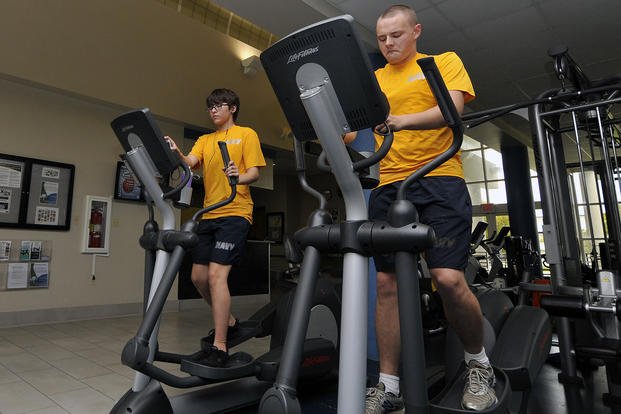Many people like to mix various cardiovascular exercises into their routines. I have found that if you are trying to lose weight (20 pounds), non-impact aerobic activities like elliptical gliders, biking, rowing and swimming make great options for a fat-burning workout. Starting a running plan when overweight can lead to overuse injuries such as shin splints, knee tendinitis, foot pain and others very quickly.
Here is an email from a reader who is comparing the benefits of machine cardio or hitting the pavement:
I have a question regarding running on a street or treadmill vs. using an elliptical machine. I find that I can "run" for longer on an elliptical machine vs. a treadmill or street running. I assume this is as a result of the relative lack of impact versus non-elliptical running.
Ellipticals are easier than running if the arms are not moving, but if you use the full-body ellipticals (mimic cross country skiing), you will burn more calories than walking or running at some speeds. But I do know many who are not that good at elliptical (both hands/feet machines) compared to running. Running is different and just requires more practice.
Am I deluding myself into thinking that by using only an elliptical machine that I am helping myself to be better at cardio and running?
Your cardio will improve, but your running ability is not likely to improve that much if you are not running. During minor injuries, often biking, elliptical gliders and rowing machines help maintain running performance while not running, but marked improvements are not likely.
Should I focus more on traditional running techniques? I would mix in some running if you are trying to improve your running speed in timed run events.
Do you have an opinion on the elliptical machine?
I like them and the bike, but only will use a high level of resistance (i.e., level 15 out of 20) as a minimum standard for the workout.
I have seen running improvement after suffering a minor injury (shin splints/ knee tendinitis), as the non-impact of biking actually rested my legs somewhat during what was probably an overuse injury (after running 30-40 miles per week). After about 3-4 weeks of no running and with spin classes, elliptical gliders, biking pyramids and swimming, my run times in a 5K actually got better.
Here are some of my favorite non-impact workouts:
Bike: Spin class
If you have never done one of these, try it at a local gym or fitness club. You will work harder in a group than by yourself.
Pyramid workouts
When on ellipticals or stationary bikes, I like to increase the level of resistance by 1-2 levels each minute until I no longer can handle the resistance. Then repeat in reverse order back to where you started. This usually takes 20-30 minutes. The first few minutes of the workout are easy (great warmup), the middle minutes are pushing maximum limits and the last few minutes are an easy cooldown. The pyramid makes for a complete workout.
Rowing
If you have access to an ergometer, give a 1,500- to 2,000-meter race a try. These are hard and will push the aerobic and anaerobic levels, depending on your effort and fitness level.
Swimming and aqua jogging
Swimming laps with or without rest in between is a great way to get a new form of challenging cardio exercise. I find the rhythmic breathing patterns of swimming translate well into running breathing patterns. If your knees are injured, do not try swimming with fins. It will place too much pressure on knee tendons.
I like to do the following swimming options:
20 x 25-meter sprints: Rest 20 seconds between each
10 x 50-meter sprints: Rest 30 seconds between each
1000-meter pyramid: May need to alter times ...
Swim 100 meters, keeping the pace between 1:20-1:40 for all.
-
Rest 30 seconds
-
Swim 100 meters
-
Rest 30 seconds
-
Swim 100 meters
-
Rest 30 seconds
-
Swim 100 meters
-
Rest 30 seconds
-
Swim 100 meters
-
Rest 40 seconds
-
Sprint 100 meters
Repeat in reverse order but rest with a 50-meter slow swim (breaststroke, backstroke, etc.).
Remember that in order to see the best fat loss in your workout, arrange it so you do your PT/weight or fast cardio first. Then follow it with a steady, conversational-paced cardio workout for 20-30 minutes.
No matter what cardio apparatus you use, just do it. Something is better than nothing. However, it is very difficult to improve at one cardio event by doing something else. It typically does not work that way unless you just need to recover from overdoing it.
If you have a running injury, check out www.drpribut.com. This is where I go for reference to all running-type injuries. Dr. Stephen Pribut is a runner and podiatrist whose website is loaded with helpful tips to reduce pain in running injuries.
Stew Smith is a former Navy SEAL and fitness author certified as a Strength and Conditioning Specialist (CSCS) with the National Strength and Conditioning Association. Visit his Fitness eBook store if you're looking to start a workout program to create a healthy lifestyle. Send your fitness questions to stew@stewsmith.com.
Want to Learn More About Military Life?
Whether you're thinking of joining the military, looking for fitness and basic training tips, or keeping up with military life and benefits, Military.com has you covered. Subscribe to Military.com to have military news, updates and resources delivered directly to your inbox.


















